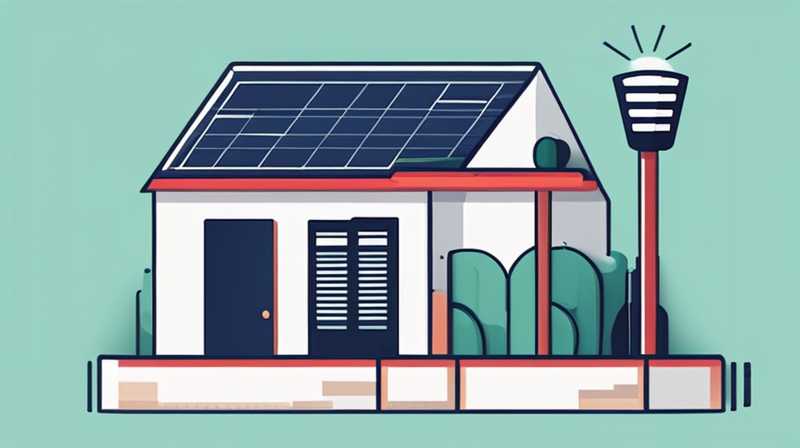
Why do solar lights keep going out? The primary causes behind solar lights failing to maintain illumination can be attributed to 1. inadequate sunlight exposure, 2. battery malfunctions, 3. component wear and tear, 4. environmental factors. Among these, sunlight exposure is pivotal; without an ample amount, the solar panels cannot generate sufficient energy to power the fixtures during the night. For optimal performance, it is essential to position the solar lights in locations that receive full sun throughout the day, avoiding shaded areas caused by trees, buildings, or other obstructions.
1. SUNLIGHT EXPOSURE
A solar light’s functionality is intrinsically linked to its ability to convert sunlight into usable energy. Solar panels harness solar radiation, transforming it into electric energy that charges an onboard battery during daylight hours. If the installation location limits sunlight exposure, such as by overhanging branches, uneven terrain, or poorly chosen orientations, the panels may not generate enough energy. The insufficient charge leads to shorter illumination times as the battery cannot store adequate energy for nighttime use.
Another essential aspect involves the solar panel’s condition. Over time, dust, dirt, and debris can accumulate on the surface of the panels, obstructing sunlight from reaching them. This can be remedied through regular maintenance, ensuring that the panels remain clean and optimally charged. A simple rinse with water and a soft cloth can often clear away the grime that inhibits performance.
2. BATTERY MALFUNCTIONS
Battery performance plays a significant role in solar light operation. Most solar-powered lights utilize rechargeable batteries to store the generated energy. Over time, batteries undergo wear and tear, leading to reduced charging capabilities. If the batteries are outdated or defective, they may fail to hold a charge, rendering the solar lights ineffective after sundown.
It is crucial to regularly assess battery health. Signs of battery malfunctions include diminished lighting duration, flickering, or sporadic illumination. Replacing old batteries with high-quality alternatives can be a prudent solution. Additionally, compatible batteries should be chosen, as mismatched sizes or voltage ratings can create incompatibility issues.
3. COMPONENT WEAR AND TEAR
The inherent nature of outdoor environments subjects solar lights to various wear and tear. Environmental exposure to moisture, wind, and extreme temperatures can impact the components of solar lighting systems. Electrical connections may corrode, LED lights might dim, or housing may deteriorate. Regular inspections can help identify potential issues before they escalate, allowing for timely repairs or replacements.
Moreover, malfunctioning components can lead to systemic failures. For instance, if a faulty light sensor intermittently fails to detect darkness, the resulting behavior could impact expected functionality. Ensuring that all components, including light bulbs, wiring, and the solar panel itself, are functioning optimally is vital in maintaining a reliable solar lighting system.
4. ENVIRONMENTAL FACTORS
The broader environment in which solar lights are placed also influences their efficiency. Seasonal changes, such as winter months with shorter daylight hours or inclement weather causing prolonged cloud cover, directly affect the amount of sunlight available for charging. It is prudent to adjust expectations based on these yearly fluctuations.
Furthermore, geographical location plays a significant role. Areas closer to the equator generally receive more sunlight year-round compared to regions farther north or south, which may experience extended periods of gloom or snowfall. Understanding local weather patterns can aid in positioning solar lights in ways that maximize efficiency and longevity.
5. SOLUTIONS AND MAINTENANCE STRATEGIES
A well-maintained solar lighting system can significantly decrease the frequency of lighting failures. Adopting a proactive maintenance schedule can ensure optimal performance. This includes consistent battery replacements—typically every few years, checking for dirt on the panel surfaces, and ensuring all connections remain intact and corrosion-free.
Moreover, positioning solar fixtures strategically, ideally in areas that receive ample sunlight for extended hours, is paramount. Shifting fixtures to more favorable locations during seasonal changes can maximize the effectiveness of solar lighting systems, ensuring reliable performance.
FAQs
WHAT IS THE AVERAGE LIFESPAN OF A SOLAR LIGHT?
The lifespan of solar lights can vary significantly based on quality, usage, and environmental factors. Generally, higher-quality solar lights can last anywhere from three to five years. Solar panels themselves can remain operable for up to twenty-five years, whereas batteries typically require replacement every two to three years. Brighter LEDs tend to have longer lifespans than traditional bulbs, and overall maintenance greatly influences longevity.
CAN I USE REGULAR BATTERIES IN SOLAR LIGHTS?
While it may be tempting to replace depleted batteries with standard alkaline batteries, this is not advisable. Solar lights are designed to be used specifically with rechargeable batteries, which are optimized for the solar charging system. Using regular batteries can lead to deterioration of the light’s internal mechanisms and may prevent them from functioning correctly.
HOW CAN I IMPROVE THE PERFORMANCE OF MY SOLAR LIGHTS?
To enhance the effectiveness of solar lights, several practices can help. Regular cleaning of the solar panels ensures they absorb adequate sunlight, and strategically positioning lights away from obstructions will optimize solar energy collection. Moreover, examining and replacing batteries periodically will offer significant performance boosts. Lastly, using high-quality solar lights designed for longevity can ultimately afford better lighting outcomes.
As a final note, maintaining solar lights often includes monitoring their exposure to sunlight and ensuring all components are in working order. Regular evaluations and routine maintenance are essential practices to sustain their functionality. By addressing potential issues related to sunlight exposure, battery life, and environmental elements proactively, users can maximize the lifespan of their solar lighting systems. The beautiful balance between technology and nature that solar lights offer is well worth the effort of consistent care. In the end, understanding the intricate components of solar lighting will result in a more dependable and sustainable lighting solution.
Original article by NenPower, If reposted, please credit the source: https://nenpower.com/blog/why-do-solar-lights-keep-going-out/


